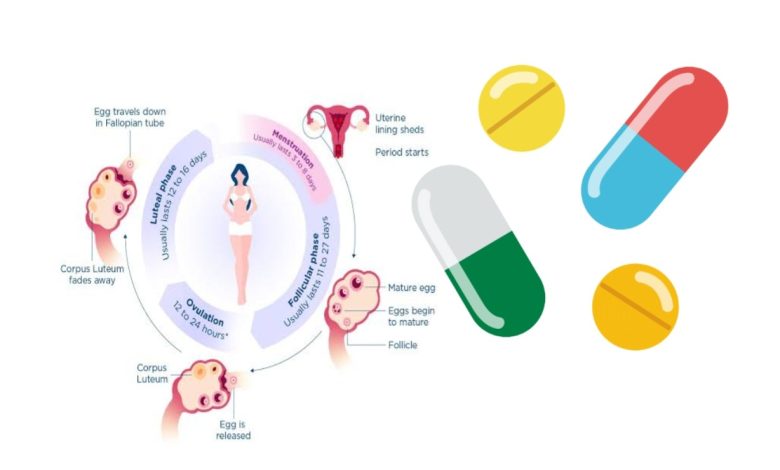8 Types Of Abnormal Menstruation and Drugs That Cause Them

Menstruation is a natural process that occurs in women’s bodies during their reproductive years. It is a monthly cycle of shedding the uterine lining, which is accompanied by hormonal changes that prepare the body for pregnancy. However, not all women have a regular menstrual cycle, and some may experience abnormal menstruation.
Irregular menstruation is a common issue among women, with many experiencing changes in their menstrual cycle at some point in their lives. The prevalence of irregular menstruation can vary depending on the definition of irregularity used, the age of the woman, and other individual factors.
According to the American College of Obstetricians and Gynecologists, a menstrual cycle is considered irregular if the length of the cycle varies by more than 7-9 days from month to month. Irregular menstrual cycles can manifest in different ways, including longer or shorter cycles, skipped periods, or unpredictable bleeding. Studies have shown that up to 30% of women experience irregular menstrual cycles at some point in their reproductive years.
In this article, we will explore the eight types of abnormal menstruation and the various drugs that cause abnormal menstruation.
Types Of Abnormal Menstruation
The 8 types of abnormal menstruation are:
1. Amenorrhea: Amenorrhea is the absence of menstrual periods. It can be classified into two types: primary and secondary. Primary amenorrhea is when a girl does not begin menstruating by the age of 16. Secondary amenorrhea is when a woman who has previously had regular menstrual cycles stops menstruating for three or more months. Amenorrhea can be caused by a variety of factors, including pregnancy, breastfeeding, hormonal imbalances, polycystic ovary syndrome (PCOS), thyroid disorders, and pituitary gland problems.
2. Oligomenorrhea: Oligomenorrhea is a condition in which a woman experiences infrequent menstrual periods. It is defined as having less than nine menstrual periods in a year. Oligomenorrhea can be caused by hormonal imbalances, stress, excessive exercise, and eating disorders.
3. Menorrhagia: Menorrhagia is a condition in which a woman experiences abnormally heavy menstrual bleeding. It is defined as having periods that last longer than seven days and/or bleeding that is so heavy that it requires changing a tampon or pad every hour. Menorrhagia can be caused by hormonal imbalances, fibroids, polyps, endometriosis, adenomyosis, and certain medications such as blood thinners.
4. Metrorrhagia: Metrorrhagia is a condition in which a woman experiences irregular bleeding between menstrual periods. It can be caused by hormonal imbalances, uterine fibroids, endometrial hyperplasia, cervical polyps, and cancer.
5. Dysmenorrhea: Dysmenorrhea is a condition in which a woman experiences painful menstrual periods. It can be classified into two types: primary and secondary. Primary dysmenorrhea is when a woman experiences painful menstrual periods without any underlying medical conditions. Secondary dysmenorrhea is when painful menstrual periods are caused by an underlying medical condition such as endometriosis, adenomyosis, or uterine fibroids.
6. Polymenorrhea: Polymenorrhea is a condition in which a woman experiences menstrual periods that occur more frequently than every 21 days. It can be caused by hormonal imbalances, thyroid disorders, and certain medications.
7. Hypomenorrhea: Hypomenorrhea is a condition in which a woman experiences abnormally light menstrual bleeding. It is defined as having periods that last less than two days or bleeding that is so light that it requires only a panty liner. Hypomenorrhea can be caused by hormonal imbalances, stress, excessive exercise, and eating disorders.
8. Anovulatory Menstruation: Anovulatory menstruation is a condition in which a woman experiences menstrual bleeding without ovulating. It can be caused by hormonal imbalances, stress, excessive exercise, and eating disorders. Anovulatory menstruation can also be a sign of polycystic ovary syndrome (PCOS) or thyroid disorders.
Drugs and Abnormal Menstruation
Abnormal menstruation is a common side effect of many medications. Some medications can cause changes in hormone levels or affect the reproductive system, leading to menstrual irregularities.
There are several drugs that can cause abnormal menstruation in women. Here are 20 drugs that have been known to cause abnormal menstrual bleeding:
1. Hormonal contraceptives: Hormonal contraceptives such as birth control pills, patches, and injections can cause abnormal menstrual bleeding in some women. These contraceptives contain synthetic versions of the hormones estrogen and progestin, which can affect the menstrual cycle.
For example, some women may experience breakthrough bleeding, which is bleeding that occurs between menstrual periods. This can be caused by a change in the level of hormones in the body. Some women may also experience lighter or heavier periods, or periods that last longer than usual.
2. Anticoagulants: Anticoagulants are drugs that help prevent blood clots from forming in the body. They work by thinning the blood, which can cause heavy menstrual bleeding in some women.
For example, warfarin is a common anticoagulant that can cause heavy menstrual bleeding. Women who take warfarin may experience prolonged or heavy periods or may experience bleeding between periods.
3. Nonsteroidal anti-inflammatory drugs (NSAIDs): NSAIDs are a group of drugs that are commonly used to treat pain and inflammation. They can affect the menstrual cycle by reducing the amount of prostaglandins in the body, which are hormones that are involved in the menstrual cycle.
For example, women who take NSAIDs such as ibuprofen or naproxen may experience heavier or longer periods, or may experience spotting between periods.
4. Antidepressants: Antidepressants are drugs that are commonly used to treat depression and anxiety. They can affect the menstrual cycle by altering the levels of certain hormones in the body.
For example, selective serotonin reuptake inhibitors (SSRIs) such as fluoxetine (Prozac) and sertraline can cause irregular menstrual bleeding in some women. Women who take these drugs may experience periods that are lighter or heavier than usual or may experience spotting between periods.
5. Antipsychotics: Antipsychotics are drugs that are commonly used to treat mental health disorders such as schizophrenia and bipolar disorder. They can affect the menstrual cycle by altering the levels of certain hormones in the body.
For example, antipsychotics such as haloperidol and risperidone can cause menstrual irregularities in some women. Women who take these drugs may experience periods that are lighter or heavier than usual or may experience spotting between periods.
6. Chemotherapy drugs: Chemotherapy drugs are used to treat cancer. They work by killing cancer cells, but they can also affect healthy cells in the body, including those in the reproductive system.
For example, cisplatin and doxorubicin are chemotherapy drugs that can cause amenorrhea or irregular menstrual bleeding in women. Cyclophosphamide and methotrexate can also cause menstrual irregularities in some women. Women who receive these drugs may experience periods that are lighter or heavier than usual, or may stop having periods altogether.
7. Thyroid hormones: Thyroid hormones are used to treat hypothyroidism, a condition in which the thyroid gland does not produce enough hormones. These hormones can affect the menstrual cycle by altering the levels of certain hormones in the body.
For example, levothyroxine is a thyroid hormone that can cause irregular menstrual bleeding in some women. Women who take this drug may experience periods that are lighter or heavier than usual, or may experience spotting between periods.
8. Corticosteroids: Corticosteroids are a group of drugs that are commonly used to treat inflammation and autoimmune disorders. They can affect the menstrual cycle by altering the levels of certain hormones in the body.
For example, prednisone is a corticosteroid that can cause irregular menstrual bleeding in some women. Women who take this drug may experience periods that are lighter or heavier than usual, or may experience spotting between periods.
9. Antihistamines: Antihistamines are drugs that are commonly used to treat allergies. They can affect the menstrual cycle by blocking the action of histamine, a chemical that is involved in the menstrual cycle.
For example, diphenhydramine and loratadine are antihistamines that can cause irregular menstrual bleeding in some women. Women who take these drugs may experience periods that are lighter or heavier than usual or may experience spotting between periods.
10. Herbal supplements: Herbal supplements are often used as alternative treatments for various health conditions. Some herbal supplements can affect the menstrual cycle by altering the levels of certain hormones in the body.
For example, chasteberry is an herbal supplement that is often used to treat menstrual irregularities. However, it can also cause menstrual irregularities in some women, including heavier or lighter periods, or periods that are more frequent or less frequent than usual.
11. Blood pressure medications: Blood pressure medications can affect the menstrual cycle by altering the levels of certain hormones in the body.
For example, beta-blockers such as propranolol can cause irregular menstrual bleeding in some women. Women who take these drugs may experience periods that are lighter or heavier than usual or may experience spotting between periods.
12. Diuretics: Diuretics are drugs that are commonly used to treat high blood pressure and edema. They can affect the menstrual cycle by altering the levels of certain hormones in the body.
For example, spironolactone is a diuretic that can cause irregular menstrual bleeding in some women. Women who take this drug may experience periods that are lighter or heavier than usual, or may experience spotting between periods.
13. Opioid pain medications: Opioid pain medications are commonly used to treat moderate to severe pain. They can affect the menstrual cycle by altering the levels of certain hormones in the body.
For example, morphine and codeine are opioid pain medications that can cause irregular menstrual bleeding in some women. Women who take these drugs may experience periods that are lighter or heavier than usual, or may experience spotting between periods.
14. Anticonvulsants: Anticonvulsants are drugs that are commonly used to treat epilepsy and other seizure disorders. They can affect the menstrual cycle by altering the levels of certain hormones in the body.
For example, valproic acid is an anticonvulsant that can cause irregular menstrual bleeding in some women. Women who take this drug may experience periods that are lighter or heavier than usual, or may experience spotting between periods.
15. Herbal teas: Some herbal teas can affect the menstrual cycle by altering the levels of certain hormones in the body.
For example, parsley tea is often used to induce menstrual bleeding in women who have irregular periods. However, it can also cause menstrual irregularities in some women, including heavier or lighter periods, or periods that are more frequent or less frequent than usual.
16. Anti-anxiety medications: Anti-anxiety medications are drugs that are commonly used to treat anxiety disorders. They can affect the menstrual cycle by altering the levels of certain hormones in the body.
For example, benzodiazepines such as alprazolam and lorazepam can cause irregular menstrual bleeding in some women. Women who take these drugs may experience periods that are lighter or heavier than usual, or may experience spotting between periods.
17. Antibiotics: Antibiotics are drugs that are commonly used to treat bacterial infections. They can affect the menstrual cycle by altering the levels of certain hormones in the body.
For example, tetracycline and amoxicillin can cause irregular menstrual bleeding in some women. Women who take these drugs may experience periods that are lighter or heavier than usual, or may experience spotting between periods.
18. Antifungal medications: Antifungal medications are drugs that are commonly used to treat fungal infections. They can affect the menstrual cycle by altering the levels of certain hormones in the body.
For example, fluconazole is an antifungal medication that can cause menstrual irregularities in some women. Women who take this drug may experience periods that are lighter or heavier than usual, or may experience spotting between periods.
19. Migraine medications: Migraine medications, such as triptans, are used to treat migraines. These drugs can affect the levels of hormones that regulate the menstrual cycle.
For example, sumatriptan is a migraine medication that can cause menstrual irregularities in some women. Women who take this drug may experience periods that are lighter or heavier than usual, or may experience spotting between periods.
20. Immunomodulators: Immunomodulators are a type of medication used to treat autoimmune disorders. These drugs can affect the levels of hormones that regulate the menstrual cycle.
For example, women who take immunomodulators may experience menstrual irregularities, such as periods that are lighter or heavier than usual, or a temporary cessation of periods.
It is important to note that not all women will experience abnormal menstruation while taking these medications. If you are concerned about the effect of a medication on your menstrual cycle, talk to your healthcare provider. Your provider can help determine the underlying cause of your symptoms and develop an appropriate treatment plan.





